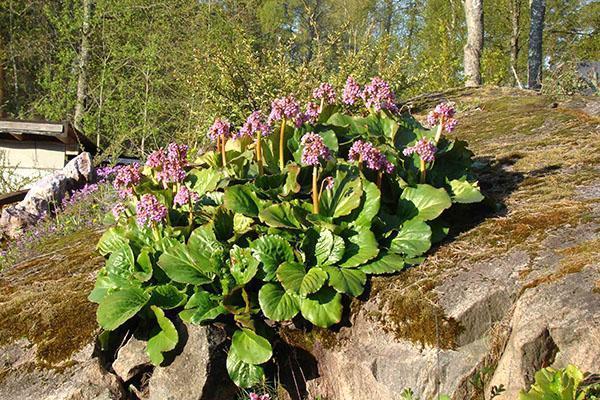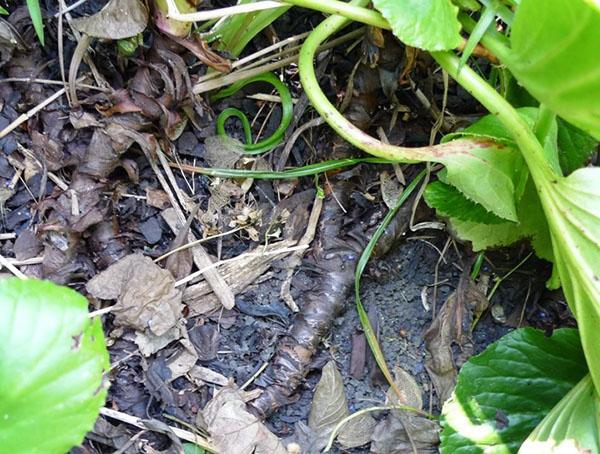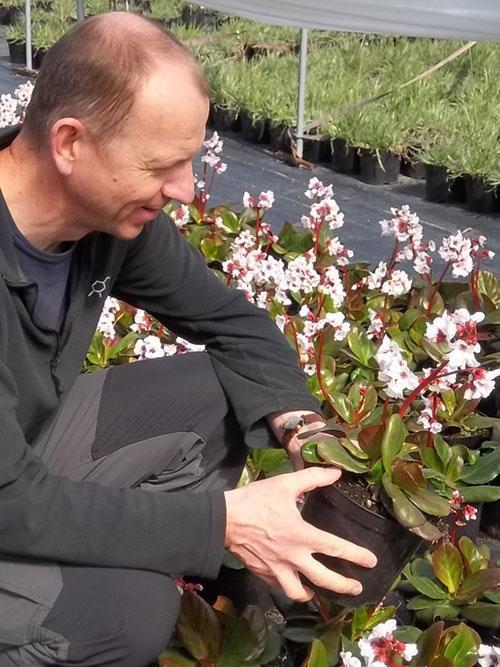Planting in open ground badan and the rules of plant care
 In a spring flower bed, one cannot fail to notice large rosettes of lush green foliage, with bright pink inflorescences on dense erect peduncles. This is an incense, planting and care in the open field for which will not cause trouble even for a beginner grower. But the garden, thanks to an unpretentious, catchy and very useful plant, will truly transform.
In a spring flower bed, one cannot fail to notice large rosettes of lush green foliage, with bright pink inflorescences on dense erect peduncles. This is an incense, planting and care in the open field for which will not cause trouble even for a beginner grower. But the garden, thanks to an unpretentious, catchy and very useful plant, will truly transform.
Perennial garden varieties of badan come from those parts of Asia where other representatives of the green world would not be too comfortable. Plants settle not only in alpine meadows and lowlands, but also on rocky ledges, highlands. Such conditions “hardened” the flower, often called saxifrage for its endurance.
In landscape design, as in the photo, badan has found its place on alpine slides and near water bodies, in group plantings with other decorative perennials. Monoplanting of this rapidly growing and forming picturesque clumps of dense foliage of culture is quite common.
Growing badan and caring for it on the site will not make it difficult for an eternally busy summer resident. The main thing is to find a suitable place for the perennial and create conditions for growth and flowering.
Where and how to plant badan?

But before you plant the badan, you need to choose a suitable place for it. The culture feels best in areas with loose, light soil. This soil helps the superficial roots to receive nutrition, oxygen, and also the much needed berry moisture.
When choosing a location, preference is given to areas where the badan will not suffer from drought and direct sunlight, as well as from the proximity of spring stagnation of water. In partial shade, the plant will be quite comfortable, but if the outlets have to spend a lot of time in the sun, the soil under it must be mulched.
Badan has no special requirements for the composition of the soil. It is great if the soil has a slightly alkaline reaction in the area where the badan is to be planted. However, even on a weakly acidic substrate, the plant can adapt, bloom and multiply.
Badan flower care after planting
 As soon as the snow begins to melt, bergenia leaves appear from under it. True, the foliage left over from last year managed to suffer during the winter.
As soon as the snow begins to melt, bergenia leaves appear from under it. True, the foliage left over from last year managed to suffer during the winter.
Therefore, in the spring, care when planting badan in the open field begins with the removal of damaged or dead leaves. Followed by the sockets complex fertilizerswhich are designed to stimulate growth and support plants during flowering.
When the pink or lilac bells in the panicle inflorescences fade, the plantings are fed again. This time, fertilizers will restore nutrient reserves and accelerate the growth of outlets.
Top dressing is combined with watering or carried out on already wet soil. Since badan reacts well to water, it must be watered:
- during the formation of buds and the appearance of peduncles;
- after two 10–20 days, if there is not enough atmospheric precipitation during this period;
- further, until the end of summer with the threat of drought.
 In the hot season, when the soil loses moisture due to evaporation, and the roots can dry out, the soil is mulched.It is especially important to do this, as in the photo, when leaving after planting bergenia.
In the hot season, when the soil loses moisture due to evaporation, and the roots can dry out, the soil is mulched.It is especially important to do this, as in the photo, when leaving after planting bergenia.
Propagation of badan
 You can get young plants of badan on the site by sowing seeds of the variety you like or by dividing an already grown plant.
You can get young plants of badan on the site by sowing seeds of the variety you like or by dividing an already grown plant.
Seed propagation of badan involves cold stratification.
Seeds sown into grooves with a depth of no more than 0.5 cm of a furrow are embedded in moistened soil and sent to the cold. Ideally, if the planting container is taken out into the open air and covered with snow, which will maintain optimal humidity and prevent future seedlings from freezing.
In early March, the container is placed in a warm place, in the light, but not in direct sunlight. At a temperature of 18–19 ºC and maintaining high humidity, the seeds begin to swell and hatch in 20–25 days.
Caring for a berry flower after planting provides for watering and careful loosening of the soil around the seedlings. If the passages are too dense, they are thinned out, leaving one plant at a time of 3-5 cm.
In 45–55 days after sowing, young plants dive, spreading from each other at a distance of at least 6–7 cm. By June, you can determine where to plant badan. But before that, the seedlings are hardened, gradually increasing the residence time of the boxes with seedlings in the fresh air. In the first half of summer, the strongest seedlings are brought into the ground. The rest are replanted in August.
Planting badan in open ground and caring for plants
 The root system of badan is located close to the surface of the soil, so making large, deep holes is not worth it. It is enough to scoop 6–8 cm soil with a scoop, and pour some sand on the bottom of the hole as drainage. Since the plant will gradually push its boundaries, grow, the interval between the holes is made at least 40 cm. After planting, the soil is compacted and watered.
The root system of badan is located close to the surface of the soil, so making large, deep holes is not worth it. It is enough to scoop 6–8 cm soil with a scoop, and pour some sand on the bottom of the hole as drainage. Since the plant will gradually push its boundaries, grow, the interval between the holes is made at least 40 cm. After planting, the soil is compacted and watered.
If the majority of perennials bloom the next year after planting in the ground, then the badan is in no hurry to show the summer resident its inflorescences. The first buds are formed only after 2–3 years, but the berry is already forming daughter rosettes.
It is an excellent planting material that can be easily separated from adult plants in summer, after flowering and until the first days of September. The rhizomes of such plots are practically under the surface of the soil or protrude above it, and even a beginner can cope with their digging.
 You need to divide the plant so that at least three healthy buds remain on the root cuttings. Leaves are cut from seedlings, leaving a pair of the strongest. Landing is carried out to a depth of 3 to 5 centimeters. In order for the berry to have room for growth, a gap of at least 30 centimeters is left between future plants. In the first month, feeding is not needed, but watering should be regular and abundant.
You need to divide the plant so that at least three healthy buds remain on the root cuttings. Leaves are cut from seedlings, leaving a pair of the strongest. Landing is carried out to a depth of 3 to 5 centimeters. In order for the berry to have room for growth, a gap of at least 30 centimeters is left between future plants. In the first month, feeding is not needed, but watering should be regular and abundant.
With proper care, the badan planted in open ground blooms a year earlier than seedlings, that is, in the second or third year after the start of independent life.
When to transplant badan? This plant can grow in one place for a very long time and without visible problems. Therefore, a transplant is taken when it is required:
- limit the growth of badan on the site;
- on the contrary, to obtain planting material for propagation from adult plants.
The uncontrolled spread of plantings leads to their excessive density, which is fraught with diseases and the accumulation of pests.
Problems in growing and caring for bergenia
 Most often, fungal diseases caused by crowding and high humidity are found on berry. Signs of such infections appear on the leaves in the form of brown or whitish spots, blackening or tissue necrosis.
Most often, fungal diseases caused by crowding and high humidity are found on berry. Signs of such infections appear on the leaves in the form of brown or whitish spots, blackening or tissue necrosis.
Affected leaf plates dry out, and the disease grows. You can cope with the trouble in growing and caring for badan:
- spraying with systemic fungicides;
- establishment of care and irrigation regime;
- rarefaction of landings in order to organize fresh air flow to the bases of the outlets.
Among the pests that damage the plant, slugs should be called, nematode and slobbering pennies. If insects can be dealt with with insecticide treatments, then worms are a big threat. The plants affected by them are dug up and, in order to prevent the spread of the nematode, are destroyed. The area where badan grew is repeatedly treated with insecticides against soil pests, and then left fallow until the next year.
Preparing garden badan for winter
 Badans are hardy, but in winters with little snow, some cultivars can freeze. To prevent the curtain from looking bare in the spring, and then not recovering for several years, the young, who have not had time to fully acclimatize, the plants are recommended to be insulated. This can be done with a thick layer. mulch, for which fallen and dried leaves, spruce branches, high-moor peat are used.
Badans are hardy, but in winters with little snow, some cultivars can freeze. To prevent the curtain from looking bare in the spring, and then not recovering for several years, the young, who have not had time to fully acclimatize, the plants are recommended to be insulated. This can be done with a thick layer. mulch, for which fallen and dried leaves, spruce branches, high-moor peat are used.